Optical illusion challenges are fast becoming a favourite online pastime across Australia, with thousands of social media users putting their observation skills to the test. The latest viral puzzle asks participants to find a hidden snail within just eight seconds. While it sounds simple at first glance, the cleverly designed image is tricking even the sharpest eyes.
Why optical illusions fascinate us
Experts say optical illusions capture attention because they play with how our brains process visual information. What may seem like a jumble of shapes or colours often conceals a cleverly disguised detail. Dr. Emily Harper, a cognitive sciences lecturer at the University of Sydney, explained that these puzzles highlight the gap between what we see and how our brains interpret patterns. “An optical illusion forces us to slow down and examine what’s right in front of us. It’s a refreshing mental workout,” she said.
The hidden snail puzzle

In the current challenge, participants are shown a busy image filled with natural elements, leaves, and textures where a single snail is camouflaged. The goal is straightforward: spot the snail within eight seconds. For many Australians who’ve attempted it, eight seconds is over in a flash, leaving them squinting at the picture for much longer. Comments flooding TikTok, Instagram, and Facebook show that only a fraction of users can complete the task in the allocated time.
Why eight seconds?
Setting a time limit adds a competitive twist. Just as with Sudoku or crosswords, the ticking clock pushes people to perform under pressure. The “eight-second” rule seems to strike the perfect balance—it’s long enough to make some success possible, but short enough to challenge most viewers. According to puzzle enthusiasts, faster completion times point to stronger concentration and sharper pattern recognition.
Australians joining the viral trend
From Melbourne to Perth, social media feeds are buzzing with screenshots of friends posting their attempts at spotting the snail. Many are sharing how long it took them, tagging mates to beat their times. Sydney-based teacher Lucy O’Brien said she uses the challenge as a classroom icebreaker: “The kids love it. We project the illusion on the whiteboard, and they shout out the moment they see it. It’s fun and it keeps their minds engaged.”
Beyond entertainment – a brain boost
Though entertaining, challenges like this are also believed to boost cognitive skills. Psychologists note that optical illusions can encourage visual focus, improve attention span, and even relieve stress by diverting the brain from routine tasks. In a world where screen time often means passive scrolling, these puzzles represent an interactive form of relaxation.
Can you beat the clock?

With Australians increasingly engaging in online brain teasers, the hidden snail challenge is shaping up to be one of the year’s most popular illusions. If you want to test your eyes and focus, pull up the puzzle, set your timer, and see if you can uncover the snail before the eight seconds are up. Whether you succeed quickly or take longer, one thing is certain: the challenge proves that appearances are not always what they seem.